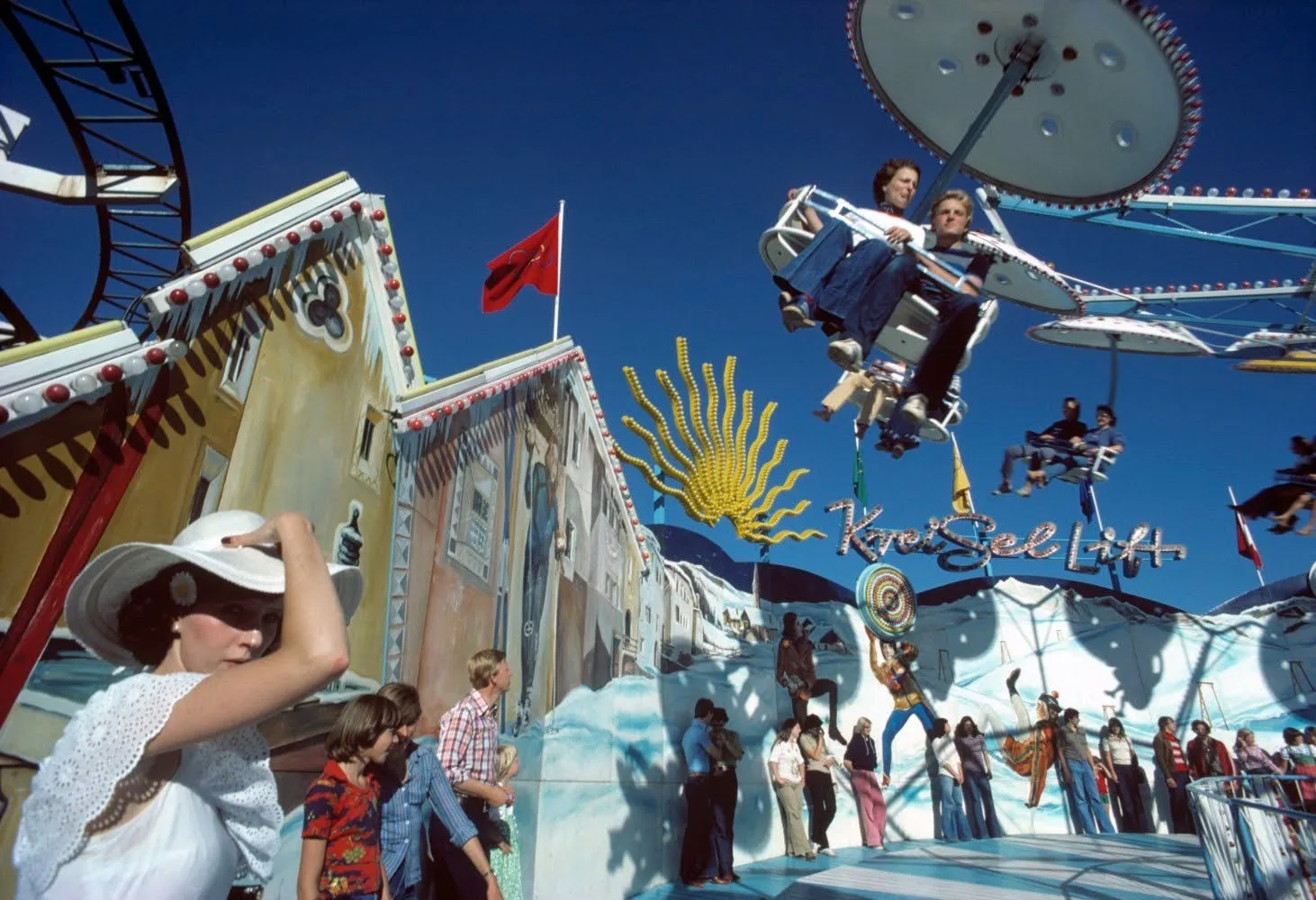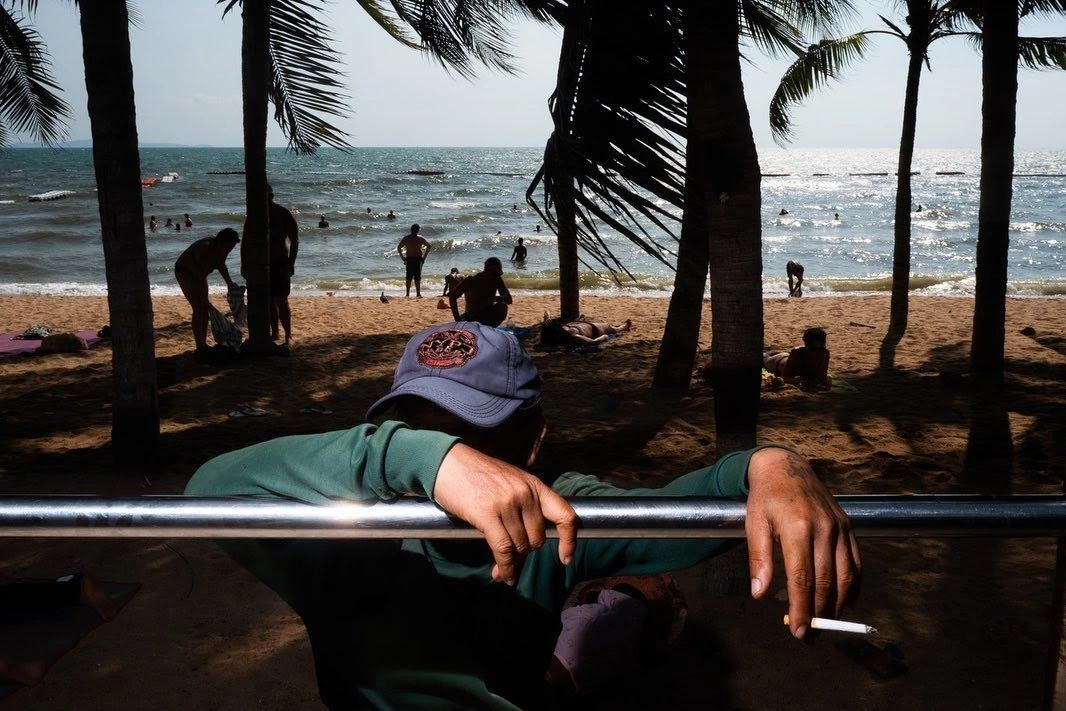It's only been an year? I feel like that time was ages ago!
Yeah, all my bad experiences with Firefox from back in the day were completely gone when I switched back to it a couple of years ago.
At some point 15-20 years ago Firefox was becoming a resource hog and I switched to chrome. I switched back a number of years ago and regret not switching back earlier.
I love it, thanks for sharing! You chose the better frame as well!
Same, but I sadly upgraded to the latest Android version because of a boot loop and things are not as snappy as they used to be. Also hangs sometimes.
I posted 2 months ago that I have no burn in. Well, I do have some from the top info bar - clock, battery level, notifications. Seems like I had never noticed?
But you're paying for a service that uses you as a product. You are paying twice.
What an American problem. 😂
New to ST, which show are the frames from?
Probably talking about new IPs? Studios are pretty risk averse nowadays.
Yes, but it's been more than 6 months since I've written in mine. I used it mainly to document my life and deal with mental issues. The past six months have been mostly daily struggles and ordinary life so I've had no incentive to go back and journal. I should fix this, grab the keyboard and resume!
BG3 is the only game in my life I've bought at launch. No regrets. This studio definitely deserves the full price tag. I've experienced like 5 bugs throughout my 130 hours of playing. I came from a poorer country and still made sense to me to vote with my wallet what games should be striving to look like on launch.
BG3 is the only game I've bought at launch price in my life. No regrets, what an amazing job from Larian.
My Karlach did not need to go to Avernus. Lives on happily ever after as an Illithid.
The bovine appears in act iii again, where you finally learn what it wants. Sort of. It's a really weird interaction.
Thanks! Now that I think about it I don't think I've ever chosen a crossbow as a main weapon in any of the games I've played. It's always the bow.
Check the journal for information. Might give you a clue.
Huh, interesting. Guess I never paid attention. I haven't figured out the difference between bows and cross bows yet and I'm in act 3, haha.
You can equip two crossbows???
Opening the door before the timer hits 00:00 actually shortens the lifespan of your appliance. Watched a video on it by a repairman.
Do you roll with failures or do you load and try for your "expected" outcome?
I used to always try for the best outcome but with this have it seems like half of the time a failure also leads to an amazing consequence and story.
Like this from act one in the Underdark:
spoiler
I had to find a hidden gnome that could supply me with gunpowder, but she was so much on edge that she lit up the barrel of gunpowder and blew up the whole room, leaving half of my party dead. A suicide gnome bomber. I couldn't convince her that I was not an enemy. Reloaded just to see if I could successfully do it, but much preferred the first outcome of the dice roll, so had to reload and try 6 times until I failed again. What a game!
In 15 hours I barged into a barn where two monsters were having sex, accidentally became worshiped by fish people and lost my eye to an amateur surgeon.
This sounds like somebody's Saturday RPG session recap. Larian have managed to capture the spirit of this quite well!
What are some fun (non-spoilery) moments you've experienced?
Santa Marta de Ribarteme, 1991, by Cristóbal Hara

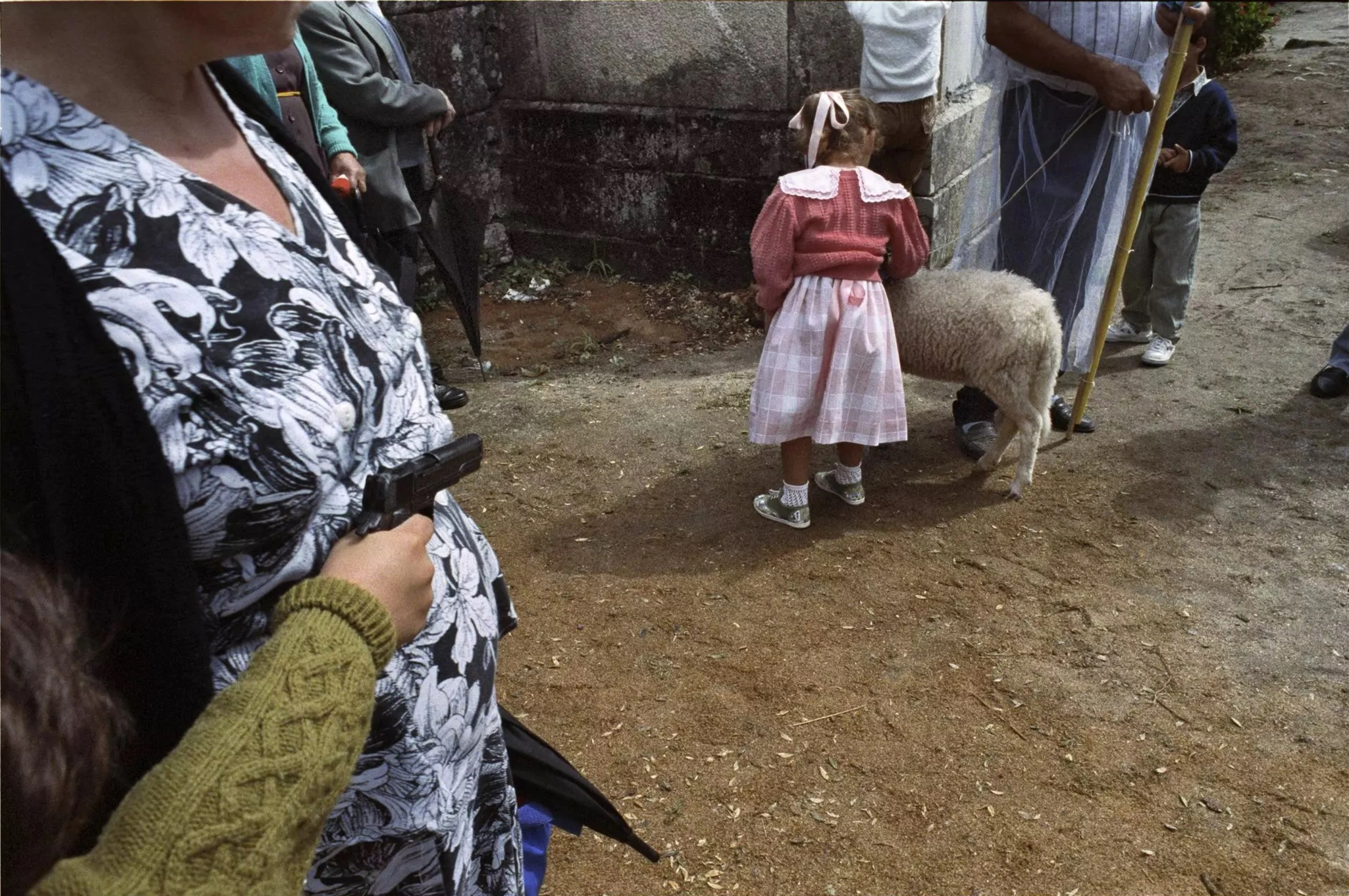
>The photographs of Cristóbal Hara show an undiscovered Spain--far from the beautiful beaches and urban centers--full of completely normal people and animals (and all their peculiarities) that reveal the extraordinary in the ordinary. At processions and markets, funerals and bullfights, or simply on the street, Hara positions his camera to extract unexpected details from the hustle and bustle of the provinces.
Capulin, Chihuahua, Mexico, 1996, by Larry Towell

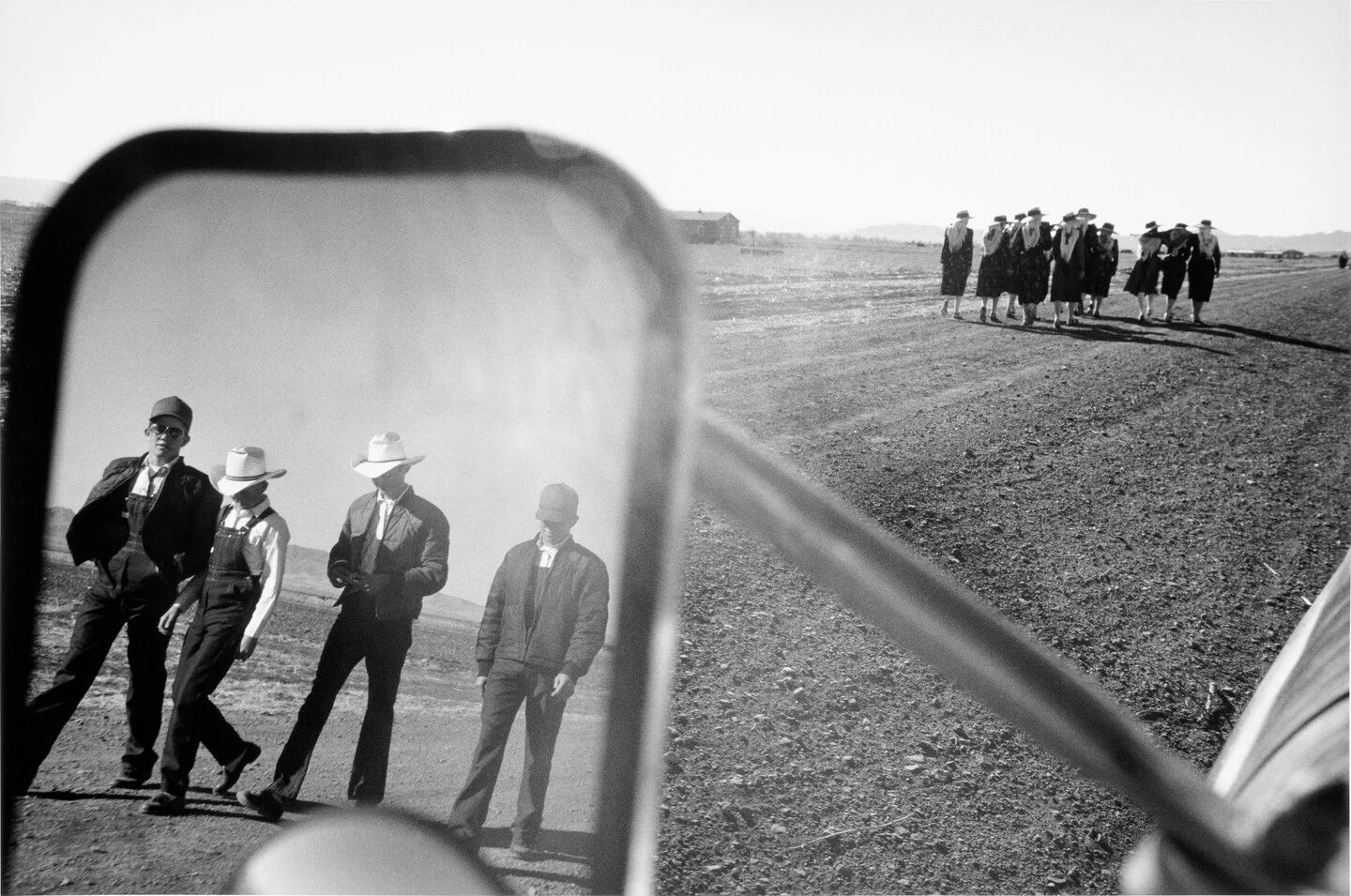
>... Towell’s work showed me that things didn’t need to be presented in neat, linear packages; you could breach the foundational tropes being taught in journalism school. And that made for much more intimate, feeling work that functioned alongside the great longform writing I had also begun to absorb.
>I don’t really know how I found it (there wasn’t really a vibrant internet community back then), but I bought “The Mennonites” that year. It’s a book of lyrical and immersive black-and-white photos exploring the world of the Old Colony Mennonites. This was no quick hit wide-shot, tight-shot package like you might produce for a newspaper story. No, Towell threw himself into the lives of the people he was photographing. He spent nearly 10 years doing it! It was an enthralling read then, and continues to be today.
Text by Kenneth Dickerman from: https://www.washingtonpost.com/photography/2022/08/17/larry-towells-iconic-mennonites-is-back-expanded-edition/
New Brighton, United Kingdom, 1985, by Martin Parr


This image is from Martin Parr's exhibition and accompanying book Bored Couples, published by Agnes B./Galerie Du Jour, 1993.
Colour photographs depict twenty bored couples who have run out of things to say to each other. The book design allows the viewer to open it from the front and from the back, so it reads French one way and English the other. Designed by Peter Brawne. Printed by Balding and Mansell, Norwich. Softback.
You can see several pages from the book on Parr's official website: https://www.martinparr.com/books/#gallery/8__3470940330/193
Yokosuka, Japan, 1966, by Shomei Tomatsu


>Though still relatively unknown outside Japan, Tomatsu, now 80, is arguably the greatest and most influential of all the photographers that emerged during his country's turbulent postwar era. Over a span of 50 years, his work has reflected, often obliquely, the changes in Japanese culture as the American military presence and then the unstoppable spread of American popular culture, helped shaped a new outward-looking, consumer-driven nation. Two series of photographs – Protest, Tokyo, 1969 and Eros, Tokyo, 1969 – record the often turbulent youth cultural changes of the time. His book, Oh! Shinjuku, named after a shopping district in central Tokyo, chronicles the rise of a young and rebellious Bohemianism that, as an older outsider, he saw – as he later put it – "through the eyes of a stray dog".
>Those words seem prophetic. Tomatsu was one of the giants of Japanese photography that a younger generation of photographers who came to prominence in the late 60s reacted against. Known as the Provoke Movement, after the magazine that published their work, it included Daido Moriyama, Takuma Nakahira and Koji Taki. In its founding statement of intent, Taki wrote: "We photographers must use our own eyes to grasp fragments of reality far beyond the reach of pre-existing language, presenting materials that actively oppose words and ideas ... materials to provoke thought." Forty years on, though, Tomatsu's radical approach – his freeform, expressionist style, odd camera angles, strange cropping and framing – has been reappraised and he is now seen, ironically enough, as one of the pioneers of the Provoke era. What he makes of all this is anyone's guess; he is famously reclusive and has never ventured outside Japan.
Text from The Guardian: https://www.theguardian.com/artanddesign/2010/sep/06/shomei-tomatsu-japanese-photography
Elmina, Ghana, 2017, by Spiros Soueref

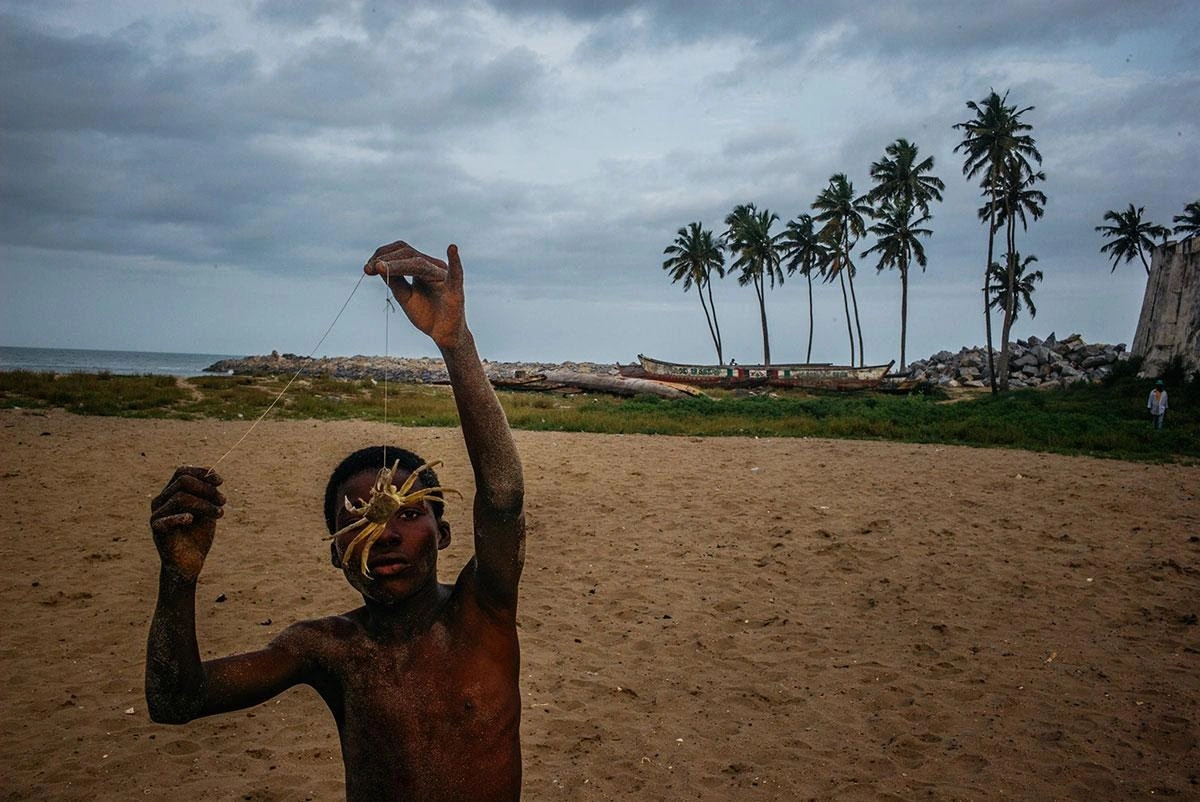
>For me traveling has always been about discovering myself through other people’s eyes. The more you get to know how they think, live and survive, the more you get to know the real world never revealed to you. You realise the confinement that all these social standards have caused and you are a part of it. A part of a prison with a camouflage of civility. And then you see purity in those eyes and those eyes set you free. They give a meaning to your entire existence. With time it is no longer a pursuit, but a way of life.
- Spiros Soueref
Bus interior by Gueorgui Pinkhassov


>"The power of your Muse lies in her meaninglessness. Even the style can enslave you if you don’t run away from it, otherwise you are doomed for repetition. The only thing that counts is curiosity. For me personally, this is what creativity is about. It testifies itself not in the fear of doing the same thing over again but rather in the urge of not going somewhere you have been before."
- Gueorgui Pinkhassov
Gueorgui Pinkhassov is known for his vivid art-reportage, which elevates the everyday to the extraordinary. His richly-colored images are absorbing, complex and poetic—sometimes bordering on an abstraction which embraces the visual complexity of contemporary life. As well as his global documentary work, Pinkhassov has photographed iconic cultural events from Cannes Film Festival to backstage at Paris Fashion Week. “It is foolish to change the vector of chaos. You shouldn’t try to control it, but fall into it” he says of his approach.
Born in Moscow in 1952, Pinkhassov’s interest in photography began while he was still at school. After studying cinematography at the VGIK (The Moscow Institute of Cinematography), he went on to work at the Mosfilm studio as a cameraman and then as an on-set photographer. He joined the Moscow Union of Graphic Artists in 1978, which allowed him more freedom to travel and exhibit internationally. His work was soon noticed by the prominent Russian filmmaker Andrei Tarkovsky, who invited him to make a reportage about his film Stalker (1979).
Moldova, Transdniester, 2004, by Jonas Bendiksen


Jonas Bendiksen’s sharply evocative images explore themes of community, faith and technology.
Bendiksen was born in Norway in 1977. He began his career at the age of 19 as an intern at Magnum’s London office before leaving for Russia to pursue his own work as a photojournalist. Throughout the several years he spent there, Bendiksen photographed stories from the fringes of the former USSR, a project that was published as the book Satellites (Aperture, 2006).
In 2017 he published The Last Testament (Aperture), which told the story of seven men who all claimed to be the biblical Messiah returned to earth. The Book of Veles (Gost, 2021) probed the vulnerabilities of our perceptions, and became hotly debated after Bendiksen revealed that what had appeared to be a classical piece of photojournalism was in large part synthetic computer-generated renderings.
Kuwait, 1991, by Bruno Barbey


"Photography is the only language that can be understood anywhere in the world" - Bruno Barbey
Bruno Barbey, born in Morocco, has dual nationality – French and Swiss. He studied photography and graphic arts at the École des Arts et Métiers in Vevey, Switzerland. From 1961 to 1964 he photographed the Italians, considering them as protagonists of a small ‘theatrical world’, with the aim of capturing the spirit of a nation.
Over five decades Bruno Barbey has worked in all five continents and covered wars and conflicts in Nigeria, Vietnam, the Middle East, Bangladesh, Cambodia, Northern Ireland, Iraq and Kuwait. His work has appeared in the world’s major magazines and he has published over 30 books.
He has received numerous awards for his work, including the French National Order of Merit. His photographs are exhibited worldwide, and feature in numerous museum collections.
Bruno Barbey died on November 9, 2020.
Information from Magnum's website.
Scarborough, 1967 by Tony Ray-Jones


>I’ve known this picture now for nearly 40 years. It was a sunny day in London in 1974 or 1975 when I walked into a second- hand bookshop on Great Russell Street, along from the British Museum, to find a copy of Tony Ray-Jones’s book A Day Off. It was marked down to £1.50 (the original price was £4.75), so I bought it. I’m not sure if this was my first sight of the picture — there was an Arts Council exhibition of Ray-Jones’s work called The English Seen going round the country at the same time. But the version in the book, the second image in, is the one I return to and have shown in lectures ever since to say something about the decisive moment, traditions in documentary, the English seaside and so on.
>Of course, it’s not only the young lovers who make this such a great picture. They are central to the image, but around them are an array of older people, their gazes outward, keen it seems to look anywhere other than at this couple in their midst. It is this refusal of social interaction which makes the picture an acute piece of satire, just as the network of divergent gazes makes it visually so satisfying. Part of my response to the picture has of course to do with my own age and background. I feel I recognise these people — their faces are like the ones that gaze out of my own family album from the period and, as I look, I assign them characters.
>The woman at bottom left with glasses and a worried look resembles my Auntie Lil and, in my mind, that is who she becomes. The old man in the flat cap is an archetypal working-class figure, though his check waistcoat, watch chain and tie clip are actually rather dressy. At the top, the boat’s captain fulfils his supporting role as weathered sea dog quite perfectly. The woman below him is another auntie and the placement of her face next to that of the girl — tilted in the same direction yet tense, almost a mask — says much about age and experience.
>To the other side of the couple stands a rather gaunt man, taking a drag on his cigarette. Here we are surrounded by all this fresh air and it’s time for a fag; defining him by his action, I call him the ‘ smoking man’. Finally, at bottom right, there is another man, whose neat white shirt and swept-back grey hair l instinctively read as middle rather than working class. He seems to have a contemplative look on his face and l’m struck by his resemblance to the English painter John Piper.
>The title as it was given in A Day Off was ‘Scarborough, 1967′. Immediately one imagines the rugged Yorkshire coast off to the left as one simultaneously thinks of hippies in San Francisco with flowers in their hair. (Somewhere out there, Simon and Garfunkel are singing the old English ballad Scarborough Fair’.) All that seems a long way away from the microcosm of this picture, but one of the things going on here (very gently) is a contrast between old English repressions and a newer, younger freedom of thought and action.
Text from Ian Walker, full text here: from: https://the-golden-fleece.co.uk/wp/tony-ray-jones-tripper-boat/
Television Set, Chidambaram Festival, Tamil Nadu, 1993, by Raghubir Singh

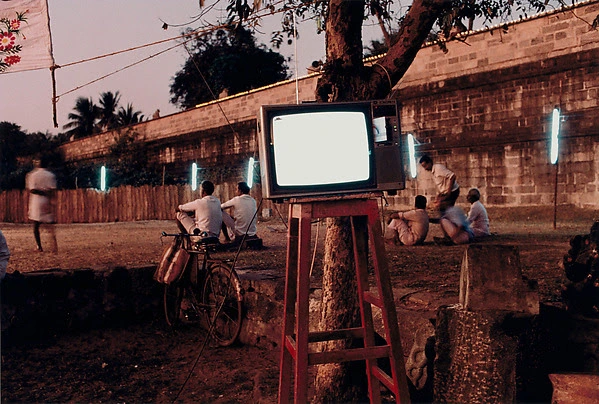
Raghubir Singh is known for his compelling and vibrant images that captured the essence of everyday life in India. With an innate understanding of color, composition, and storytelling, Singh's photographs portrayed the rich tapestry of Indian culture, from bustling city streets to rural landscapes. His work transcended mere documentation, evoking a sense of intimacy and connection with his subjects. Singh's iconic photographs, often taken with a keen eye for detail and a deep appreciation for the play of light and shadow, celebrated the vibrant colors and diverse traditions of India. Through his lens, he revealed the complex layers of the country's social, cultural, and religious landscapes, leaving a lasting impact on the world of photography. Raghubir Singh's profound artistic legacy continues to inspire photographers and viewers alike, capturing the beauty and complexity of India with unwavering passion and sensitivity.
Syracuse, New York, USA, 1981 by Bruce Gilden


>Gilden spent his time in Syracuse shooting at the sorts of mass gatherings he had been focusing on at the time – state fairs, fetes, picnics and parties – as well as working his way into the homes of the city’s blue-collar residents. He also photographed the local assisted living communities, impressed by what he saw as the distinctly open-minded attitudes toward them, evident in the local population.
Quote from Magnum's website.
Dobrinja suburb in Sarajevo, 1995 by Tom Stoddart


>Tom walked into my office with a startling portfolio in which one jumped out; her name was Meliha, a striking, defiant, beautiful woman, dressed to allure in a city without medicine, or make-up. A city where women were reduced to using berry juices for rouge or lipstick. Meliha wore her beauty with pride and defiance as she strode down what was called Sniper Alley, in heels, stockings and pearls, knowing a bullet might end her life at any moment.
Quote by Robin Morgan, Editor in Chief, Sunday Times Magazine. 1991-2009
Meiji shrine photographed by Werner Bischof, 1951

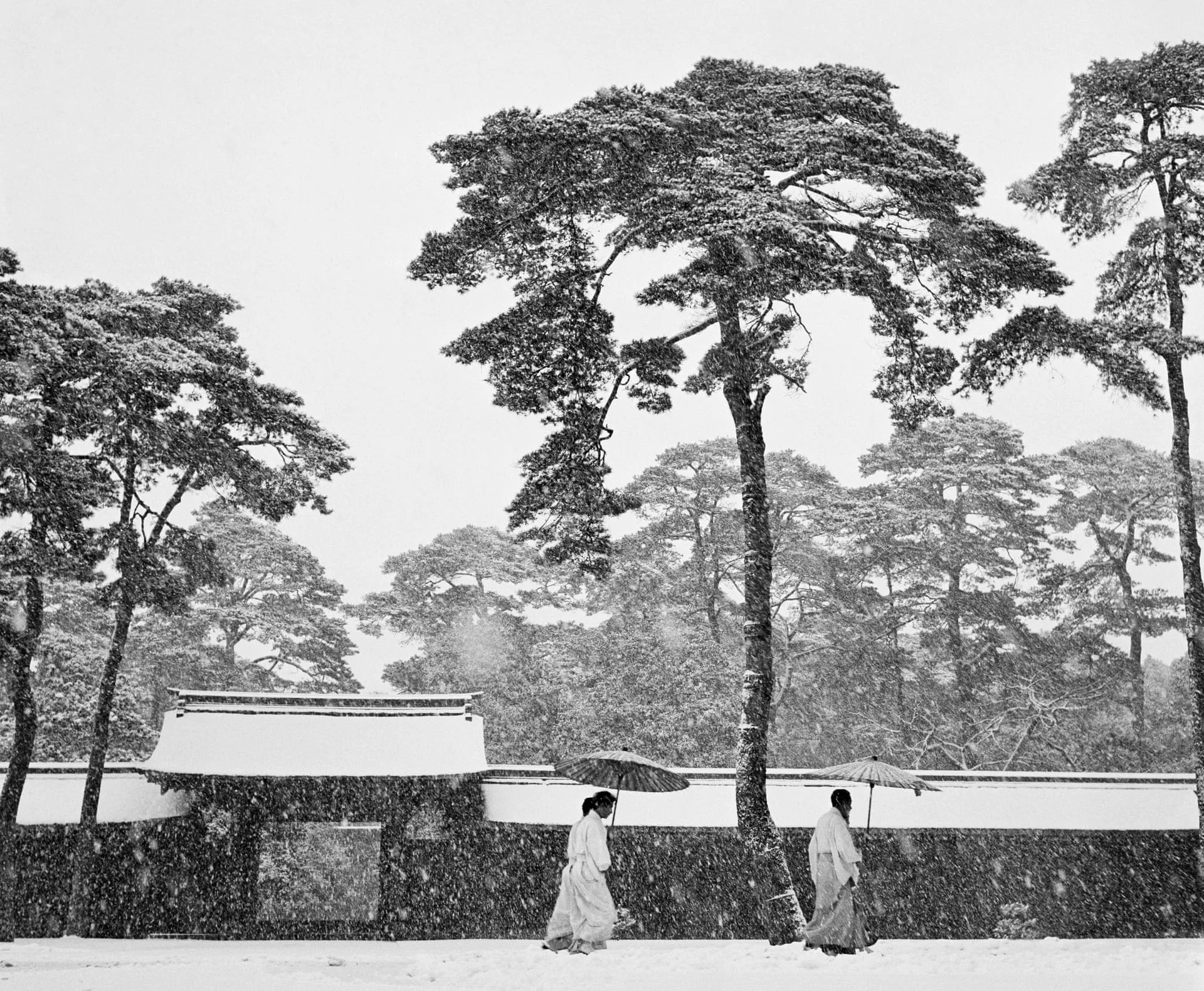
On 17 September 1951, while he was in Tokyo, Werner Bischof wrote a letter to his wife Rosellina, telling her: ‘The trees are quite exquisite in Japan. You know the poems that tell of the wind blowing through the trees and the leaves. In the centre of the capital, with its ever-increasing bustle, I have discovered some tree shapes of breathtaking beauty, and have drawn them for you. I cannot believe that these people will ever stop venerating nature, that a time will come when they no longer shelter trees and flowers in their houses as symbols of what is noble and pure…’
Rosellina joined Bischof in Japan for three months. During that time, he took the photograph of the Shinto priests in the garden of the Meiji shrine in Tokyo. The story goes that he suddenly ran off and followed the priests. When he returned, he told Rosellina: ‘Now I have the picture of Japan!’ He realized the importance of his photograph immediately. It is also possible that he had in mind the famous screen painted by Master Hasegawa Tōhaku with a depiction of pine trees.
Here's his contact sheet from that roll of film:
*Text and image from the Magnum website.
New community for the appreciation and discussion of the art of street photography!
Hey everyone!
I've given myself the liberty to create a community for street photography enthusiasts. I'm sure a lot of people can appreciate the magic of the everyday, of the small moment. You're welcome to join in and celebrate good photography!
Who are your favourite street/documentary photographers right now?
I can't seem to be able to get enough of Jason Eskenazi, Nikos Economopoulos, Fabio Ponzio, Chris Killip and Larry Towell at the moment. I constantly go back and flip through their books I own.
I've been shooting mostly color for the past two years, but their black and white work is remarkable.
What are yours?

